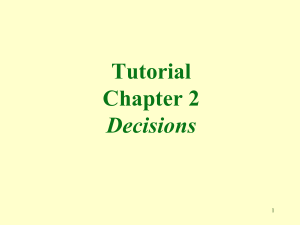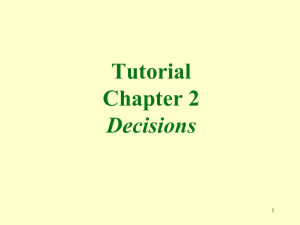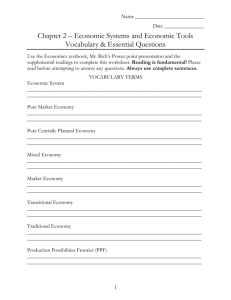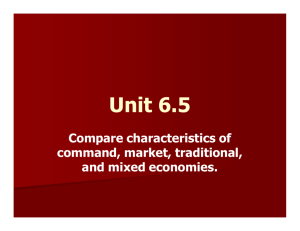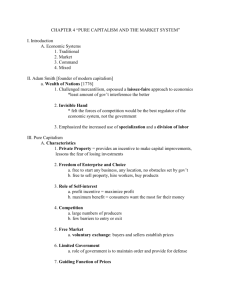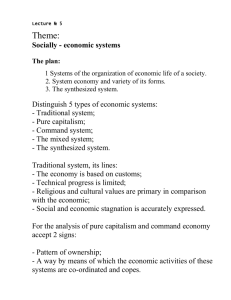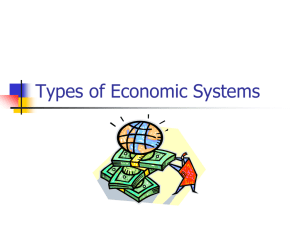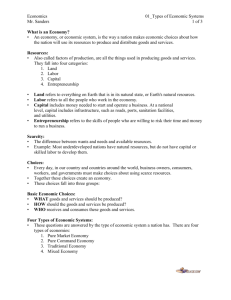Multiple Choice Tutorial Chapter 2 Some Tools of Economics Analysis
advertisement
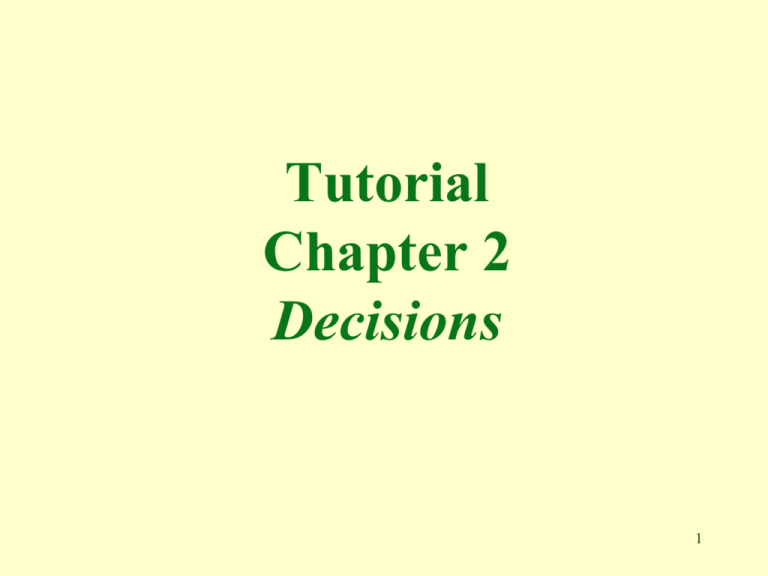
Tutorial Chapter 2 Decisions 1 1. A perfectly free market can provide society with everything it needs. False The market fails in many aspects of meeting our needs and therefore it has to be modified. A free market system needs a strong government to function efficiently. 2 2. If the federal government interferes with the price mechanism too much, communication among its parts will begin to break down as price signals blur. True A free market system can only function smoothly if there is ample communication among its various parts. 3 3. Rent seeking occurs when big business financially supports politicians to influence legislation. True When a business lobbies Congress instead of spending the money on better production, it is involved in rent seeking. 4 4. Moral hazard occurs when a business is insulated from risk and therefore behaves differently than it would if it were fully exposed to risk. True Moral hazard is a consequence of rent seeking. Caution is thrown to the wind when people are not held responsible for their actions. 5 5. If we developed a fertility drug doubling the number of cows, economists would say that the supply of cows has increased. False Economists only consider events if there is a market transaction. Economists are less concerned about how many cows we have standing on four feet as they are about how many cows are brought to market. 6 6. Strictly speaking, money is considered capital. False Capital is defined as the machines, buildings, or tools used in the productive process. Money does not fit this definition of capital. Money that is used to purchase capital is called financial capital. 7 7. It is folly for a society to always want more goods and services. When society has plenty of everything, people should be satisfied with what they have and not always want more. False The problem of being satisfied with what we already have is that everything wears out over time. If we do not consistently replace what we have, tomorrow we will have less. 8 8. Some economic goals are conflicting. True Society is always faced with conflicting goals because of opportunity costs. If we spend more on a clean environment we will have fewer resources devoted to the military, and vice versa. 9 9. Pollution is a negative externality. True Negative externalities are the negative by-product of the industrial process. 10 10. America is rich enough in natural resources and capital that we would not be harmed if we did not trade with other nations. False Despite are wealth the standard of living for the average person would diminish if we did not trade with other nations. 11 11. The old adage of “the rich get richer and the poor get poorer” is an accurate assessment of how the economy works. True There is a natural law whereby those people who have the most receive more than people who have less. The more you have, the more you will be given. The less you have, the less you will be given. 12 12. Crony capitalism can lead to moral hazard. True Crony capitalism is a system whereby the government and the means of production are controlled by a handful of private individuals who arrange the economy to benefit only themselves. This presents a moral hazard situation because even in failure these people gain financially and therefore are risk adverse. 13 13. The law of comparative advantage states that the person who should produce a good is the person who a. has the lowest opportunity cost of producing that good. b. can produce that good using the fewest resources. c. will produce that good using the most expensive resources. A. Every decision you make entails an opportunity cost, you always give up something when you make decisions. 14 14 Comparative advantage a. leads to all of the following. b. leads to the most efficient allocation of resources and the greatest combined output. c. eliminates specialization, so that each person produces for all of his own needs independently. B. Should a country produce those goods that it is best at producing? Not necessarily. For example, let’s suppose Americans were better than any anyone else at producing hand made wicker baskets, should we spend our time and energy producing baskets? No, because that time and energy would be better spent in the technology area, like computers. 15 15. What is crony capitalism? a. Occurs when cronies participate in the free enterprise system. b. A system where success in business depends on close relationships between business and government. c. An economic system that is totally free of government interference. d. An economic system which is highly regulated. B. Instead of the government regulating and overseeing the business sector the government becomes a partner of big business. 16 16. Because of specialization and comparative advantage, most people a. consume only what they produce themselves. b. consume the products produced by their family and friends. c. consume the products of many other specialists. C. Because of specialization and the fact that people pursue activities that they have a comparative advantage, we do not have to be self-sufficient. By specializing and then buying from one another, our standard of living increases. 17 17. The “division of labor” refers to a. discrimination in labor markets. b. separating a job into smaller tasks completed by different people. c. one worker who divides his time among different jobs and duties. d. defining a job according to the appropriate sex. B. One of the characteristics of a modern industrial society is the specialization of labor. This leads to a higher standard of living because it eliminates some nonproductive activity, among other things. 18 18. Specialization of labor a. increases productivity without creating any problems. b. reduces productivity, and is usually eliminated by business firms. c. can create problems of boredom and repetitive motion injuries. d. prevents the introduction of more sophisticated and efficient production techniques. C. On an individual basis, the division of labor has the downside of boredom and physical and emotional type problems. 19 19. When the government increases spending the money comes from a. taxes. b. debt. c. thin air. d. all of the above D. These are the three places the government gets money. It can raise taxes, borrow more, or it can create the money. 20 20. If the government borrows to increase spending, we do not pay for it now, only later. a. True b. False c. Can’t tell d. Depends on who lends the money B. A dollar spent today is paid for today regardless of where it comes from. We either pay for it in terms of higher taxes, higher interest rates, inflation or the negative effects of a misallocation of resources. 21 21. “Efficiency” refers to a. producing output using the least amount of labor. b. producing output using the least amount of capital. c. producing as far inside the production possibilities frontier as possible. d. getting the maximum possible output from available resources. D. A country is being most efficient when it uses its resources the best way possible. 22 22. If all resources are used efficiently to produce goods and services, the nation will find itself producing a. inside its production possibilities frontier. b. somewhere on its production possibilities frontier. c. outside of its production possibilities frontier. d. at one extreme of its production possibilities frontier. B. If a country uses its resources inefficiently it will operate inside its production possibilities curve. If it produces at the most efficient level possible it will operate on the curve. It is not possible to operate beyond its most efficient frontier unless it increases its resources or becomes more efficient. 23 23. Opportunity cost is constant if a. resources are equally adaptable to the production of all goods. b. each resource is specialized in the production of one particular good. c. larger and larger sacrifices must be made to gain equal successive amounts of a good. d. all resources are used fully and efficiently. A. This is an unrealistic assumption, but is sometimes made. For example, if you were a farmer, this would mean that an acre of land will yield the same amount no matter what crop you plant on the acreage. The land is equally suited for all crops being considered. This is not realistic. 24 24. The set of mechanism and institutions that resolve the basic economic questions is called the a. economic system. b. production possibilities dilemma. c. business resolution device. d. absolute advantage determination. A. All countries have to have some mechanism to decide what to produce, how to produce, and who gets what and how much. The economic system, whether it be a free market system or a command system, is the mechanism countries use to answer these questions. 25 25. Pure capitalism and command economies represent a. two extremely different ways of answering the basic economic questions. b. two names describing exactly the same way of answering the basic economic questions. c. the only two ways of answering the basic economic questions. d. the most efficient ways to answer the basic economic questions. A. A command economy is one where the central government makes all of the economic decisions. Capitalism is a system where the decisions are made by private individuals based on the profit motive. 26 26. Which of the following does not distinguish between different types of economic systems? a. Laws about resource ownership. b. The extent of government involvement in the economy. c. Whether or not the basic economic questions must be answered. d. What process is used to allocate resources and products. C. No matter the economic system, the basic economic questions must be answered. 27 27. Which of the following is a characteristic of a planned economy? a. All resources are privately owned. b. Economic activity is coordinated by the price system. c. Competitive markets guide resources to their highest-valued uses. d. Centralized economic planning is used to answer basic economic questions. D. Friedrich Hayek’s explains in his book The Road to Serfdom how centralized planning can lead to a loss of personal freedoms and economic stagnation. 28 28. Which of the following is a characteristic of pure capitalism? a. All resources are owned communally. b. Economic activity is coordinated by government decision makers. c. The price system is used to guide resources to their highest-valued uses. C. Because individuals are making decisions to maximize their welfare and profit, consumers will purchase at the lowest price possible and suppliers will sell at the highest price possible. The market is at equilibrium where the two parties reach an agreement. 29 29. Problems with pure capitalism include which of the following? a. People have no incentive to direct resources to their highest-valued use. b. The active government involvement in controlling the economy may not be in the best interest of the individuals involved. c. Public goods, while desirable, may not be produced. C. This is why we have modified capitalistic system; we have modified it in an attempt to rectify some of its weaknesses. We support a government that taxes us and then uses the tax money to support things that would not exist in a purely free enterprise system. 30 30. Problems with a pure command economy include which of the following? a. Property rights cannot be enforced. b. Public goods, while desirable, may not be produced. c. The lack of a legal system makes it impossible to create contracts. d. Large, diverse economies may be extremely difficult for central authorities to analyze and control. D. Command economies may have some advantages, but one of the big disadvantages is the fact that large complex and diversified economies are difficult to analyze and control by any one central authority. 31 31. With regard to pure capitalistic economies and pure command economies, a. all real-world societies are purely capitalistic. b. all real-world societies are pure command. c. all real-world societies are purely capitalistic or purely command. d. real-world societies are usually a mixture of command and capitalism. D. Even our own American system, even though it is primarily a free market system, has some aspects of a command system in it. 32 32. A mixed capitalist economy occurs when a. decisions are based primarily on religion or custom. b. all resources are publicly owned and economic planning is centralized. c. all resources are privately owned and prices are used to coordinate economic activity. d. resources are both publicly and privately owned and some markets are regulated. D. Some economists call our type of economic system a mixed economic system because we have aspects of both systems. 33 END 34
